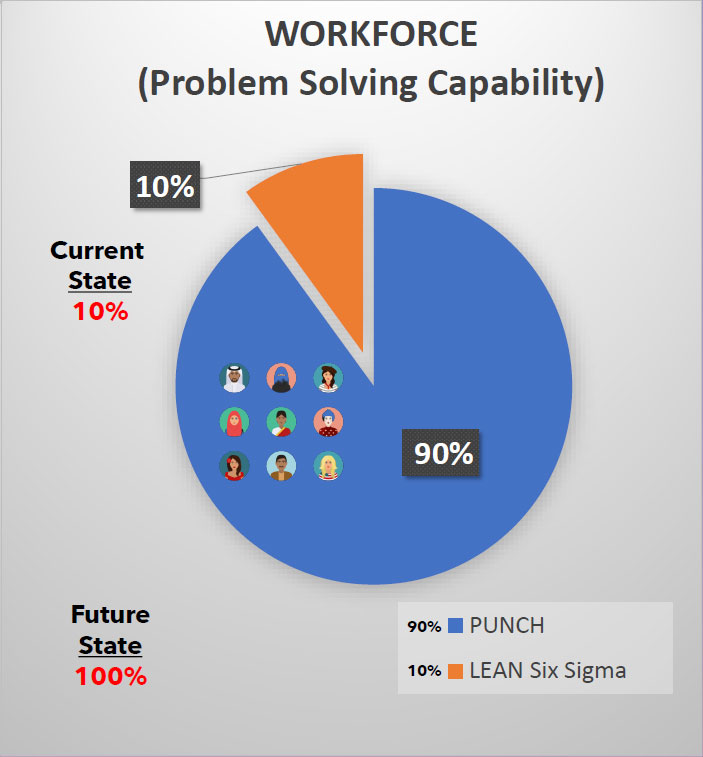
“You may not fully understand problem complexity, but you certainly know when customers are unhappy!”
Tyrone Butler
ASC - VP of Operations
PUNCH
No one needs a complicated definition to describe a business problem or customer pain issue.You see them all the time in every commercial and public industry. You may not fully understand the complexity of the issue, but you certainly know when an internal or external customer is unhappy with a requested outcome or deliverable.
PUNCH methodology, by contrast, is what helps you define proactively and reactively the root problem or problemsthat need to be solved in order to meet or exceed the expected customer outcomes or behaviors.
“A problem well stated is a problem half solved!”
-Charles Kettering, Head of Innovation, GM
THE FAB 5 APPROACH TO AUTOMATION
-
Looking at an Automationupgrade as a magic fix for all business problems is usually a recipe for failure. It is also a symptom of poor “Digital Transformation” and “Operational Excellence” planning.
-
Many people believe that Automation aloneis the key to winning in business. They believe it clearly defines the collaboration of human activity with business technology. Most often it creates more problems than solutions..
-
Automationattempts to automate processworkflows from person to person and person to systemto reduce cost, become more efficient and meet customer needs.
-
They also believe that teams can work smarter, faster, and be more connected than ever before as Automationis adopted across the business.
-
When the human factors are removed from a process by Automationit speeds up the original process and the expectation is that you get faster results and more accurate outcomes.
-
This is an expectation that is rarely met.
-
If the original human process had a poor design,then Automationjust speeds up the original inefficiencies and increases the back log of poor results.
-
You need an optimal process analysis and redesign to achieve the best human to system, system to system, and system to cloud interfaces that yield minimal cost, delays, resources use and inaccuracies.
-
All human based processes should be 1stassessed by PUNCH Methodology to determine the next steps course of action to achieve desired results or outcomes.
-
After the PUNCH Assessment , processes can be improved using the correct path to success based on the FAB 5 approach below:
“FAB 5 APPROACH”
-
PUNCH (START HERE)
-
LEAN
-
SIX SIGMA
-
SEMI AUTOMATION
-
FULL AUTOMATION
“PUNCH, IS A GREAT TOOL TO ENSURE FROM THE BEGINNING, ALL OF OUR CONTINUOUS IMPROVEMENT PROJECTS HAVE OPTIMAL LEVELS OF ENGAGEMENT AND SUPPORT”
Damon Sylvestry, VP, Operations
Life Sciences Industry

-
PUNCH methodology is always first. It uses problem identification tools to optimally determine the fastest most effective methodology to use to solve any level of problem complexity.
-
A Problem is any issue on concern raised to a business by a customer to resolve.
-
Automation of a broken or poor performing process should never be the start of improvement
-
PUNCH always requires an initial assessment to determine the best action to solve issues
-
The key PUNCH components that dictate the starting point of problem solving are the following:
-
Problem Complexity (80% of selection)
-
How long has the problem existed?
-
If seen before, what was the previous fix?
-
What is the Key metric to improve? (5 Whys)
-
Does data exist today regarding the issue?
-
Will this project get full management support?
-
Does the project align with the company Mission and Vision objectives?
-
Is this a priority to resolve now or later?
-

PUNCH ,ALLOWED US TO COMPLETE QUICK WIN PROJECTS TO LOW COMPLEXITY ISSUES WHILE MANAGING MORE COMPLEX PROJECTS USING LEAN AND SIX SIGMA.
A WIN –WIN RESULT FOR OUR TEAM!
Dan Alvarado, Dir. Quality and Innovation
Manufacturing
-
PUNCH methodology is not a replacement for any current “Continuous Improvement” methodology.
-
PUNCH is a preliminary activity that is always initiated at the beginning of a “Continuous Improvement” effort or project.
-
Why is it needed at the beginning?
-
All “Continuous Improvement” efforts are not complex problems that required a rigorous, technical approach to problem solving.
-
> 90% of poor process results is due to poor process design.(Not peopleor environment)
-
PUNH always requires an initial assessment to determine the best action to solve issues
-
PUNCH projects are quick win projects that do not require the traditional structure, time and framework for execution like formal Lean, Six Sigma, Kaizen, Agile or any other known “Continuous Improvement” methods or thinking.
-
Here are a few best fit PUNCH method examples:
-
Data collection to understand “True” issue
-
Pareto data to define “True Root” problem
-
Low Complexity Issues to solve quickly
-
Process analysis for Automation efforts
-
WE STARTED WITH MANY PROCESSES AND DELIVERABLES THAT WERE EITHER DELAYED OR INACCURATE.WE USED PUNCHTO IDENTIFY AND SOLVE FOR THE “QUICK WINS”.THESE IMPROVEMENTS WILL BE CONTINUED INTO THE FUTURE!
Head of Quality
Saudi FDA
-
What is the difference between PUNCH and Lean Six Sigma projects?.
-
What is the difference between PUNCH and Kaizen?
-
Why is it needed at the beginning?
A Typical Lean or Six Sigma Project vs. PUNCH Project
LEAN SIX SIGMA

LEAN or Six Sigma Project Execution Actions or Challenges:
-
If a Project is a “Quick Win” (No way to assess the opportunity at the beginning)(Time Delay)
-
If the Primary metric data is missing or poor at project start ?
-
Current project coverts to discovery not improvement (Poor ROI)
-
Project converts to data collection for a future project (Poor ROI)
-
-
The DMAIC delivery structure is required every project (Time Delay)
-
A scheduled Toll gate review required after each phase (Time delay)
-
A Problem-Solving team is needed regardless of complexity (More Tools used than needed)
-
No alternative method to solve low complexity problems or issues (No PUNCH method)
-
PUNCH

PUNCH Project Execution Actions or Challenges:
-
If a Project is a “Quick Win” –use PUNCHto understand, identify needs, change, and make improvement a habit. (PUNCH –Problem, Understand, Needs, Change and Habit)
-
If the Primary metric data is missing or poor at project start ? Use PUNCH to get data for future “Continuous Improvement” effort or simple PUNCH project
-
No standard Toll gate review required (All problems solved in < 30 days) (Better time use)
-
Higher complexity problems are identified and sent to other “Continuous Improvement” methods before a PUNCH project start (Ensures best methodology used for each project!)
PUNCH,PROBLEM SOLVING, BEFORE LEAN AND SIX SIGMA!
“Lean Six Sigma is great!
10% of my workforce is trained to solve the most complex problems in my business!
What can you teach the other 90%to solve simple problems and create a culture of “Continuous Improvement” across the entire Enterprise?
Jack Welch
CEO, General Electric



